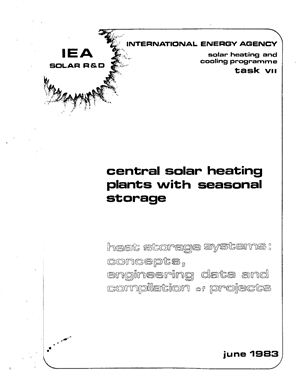На английском языке. A report within IEA Heating and Cooling
Program – Task 7, 1983, 212 pages.
The aim of this part of the Subtask work was to gather information conceing seasonal heat storage simulation models, their capabilities and availabilities, to present in some detail several models suitable to the needs of Task VII, and, finally, to select models compatible with the optimization tool {the MINSUN program) and the analytical tool (the TRNSYS program) chosen in Subtask la.
In the resulting report, a general overview of about 50 existing heat storage models in the ten participating countries in 1981 is presented.
The information was processed by Lead Country 1c, based on questionnaires which were distributed to the participants at the beginning of the Task.
Considering this basic information, a more precise analysis was performed for about 20 models, which were identified as being available.
A detailed analysis was then executed for 15 models classified in 3 categories:
models for water tank, pit, and cave storage systems; models for earth and rock storage systems; models for aquifer storage systems,
and typical test cases were submitted to the authors of the models.
Considering the capabilities, size, and results of each evaluated model, and keeping in mind the specialities and constraints of Task VII, the participants decided to choose a set of programs developed in Sweden by Lund University. These are the following SST: Stratified Storage Temperature Model (for tanks, pit, and cave)
DST: Duct Storage Model (for earth and rock storage)
AST: Aquifer Storage Model (for aquifer storage)
These models are based on 2-D explicit finite differences, and they basically solve the heat conduction equation in soils.
For water storage in tanks, pits, and caves, vertical stratification is accounted for.
For earth and rock storage, the local processes around pipes or ducts, and the global processes (storage losses) are treated with a superposition method.
For aquifer storage, a special technique is used to take into account the convective terms in a one-well or doublet system with prescribed horizontal water flow.
The models have the basic advantage to be complete (with few restrictions), while not consuming too much computer time. Furthermore, they are at least partly validated.
The integration of the models into TRNSYS and MINSUN, by their authors directly, started in Sweden in 1982 with a lower priority for AST, due to time constraints.
The aim of this part of the Subtask work was to gather information conceing seasonal heat storage simulation models, their capabilities and availabilities, to present in some detail several models suitable to the needs of Task VII, and, finally, to select models compatible with the optimization tool {the MINSUN program) and the analytical tool (the TRNSYS program) chosen in Subtask la.
In the resulting report, a general overview of about 50 existing heat storage models in the ten participating countries in 1981 is presented.
The information was processed by Lead Country 1c, based on questionnaires which were distributed to the participants at the beginning of the Task.
Considering this basic information, a more precise analysis was performed for about 20 models, which were identified as being available.
A detailed analysis was then executed for 15 models classified in 3 categories:
models for water tank, pit, and cave storage systems; models for earth and rock storage systems; models for aquifer storage systems,
and typical test cases were submitted to the authors of the models.
Considering the capabilities, size, and results of each evaluated model, and keeping in mind the specialities and constraints of Task VII, the participants decided to choose a set of programs developed in Sweden by Lund University. These are the following SST: Stratified Storage Temperature Model (for tanks, pit, and cave)
DST: Duct Storage Model (for earth and rock storage)
AST: Aquifer Storage Model (for aquifer storage)
These models are based on 2-D explicit finite differences, and they basically solve the heat conduction equation in soils.
For water storage in tanks, pits, and caves, vertical stratification is accounted for.
For earth and rock storage, the local processes around pipes or ducts, and the global processes (storage losses) are treated with a superposition method.
For aquifer storage, a special technique is used to take into account the convective terms in a one-well or doublet system with prescribed horizontal water flow.
The models have the basic advantage to be complete (with few restrictions), while not consuming too much computer time. Furthermore, they are at least partly validated.
The integration of the models into TRNSYS and MINSUN, by their authors directly, started in Sweden in 1982 with a lower priority for AST, due to time constraints.

